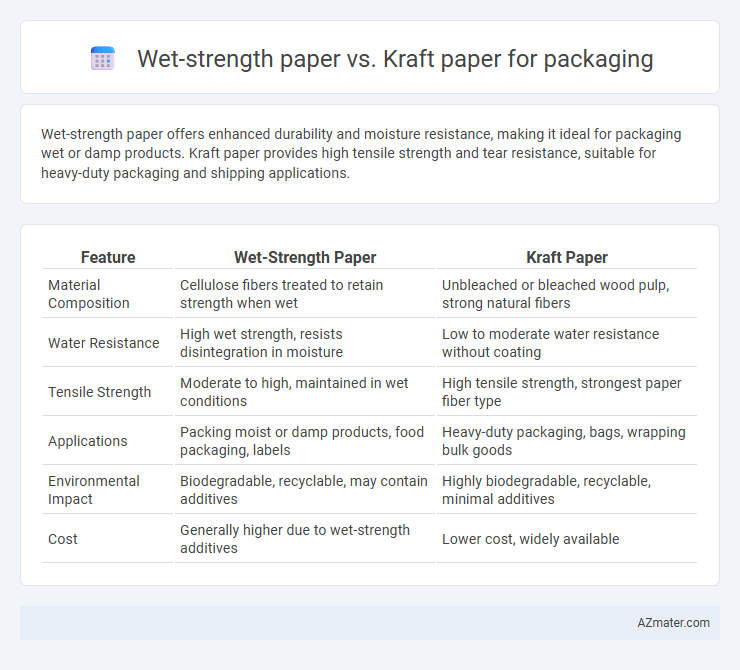Wet-strength paper offers enhanced durability and moisture resistance, making it ideal for packaging wet or damp products. Kraft paper provides high tensile strength and tear resistance, suitable for heavy-duty packaging and shipping applications.
Table of Comparison
| Feature | Wet-Strength Paper | Kraft Paper |
|---|---|---|
| Material Composition | Cellulose fibers treated to retain strength when wet | Unbleached or bleached wood pulp, strong natural fibers |
| Water Resistance | High wet strength, resists disintegration in moisture | Low to moderate water resistance without coating |
| Tensile Strength | Moderate to high, maintained in wet conditions | High tensile strength, strongest paper fiber type |
| Applications | Packing moist or damp products, food packaging, labels | Heavy-duty packaging, bags, wrapping bulk goods |
| Environmental Impact | Biodegradable, recyclable, may contain additives | Highly biodegradable, recyclable, minimal additives |
| Cost | Generally higher due to wet-strength additives | Lower cost, widely available |
Overview of Wet-Strength Paper and Kraft Paper
Wet-strength paper incorporates chemical additives that significantly enhance its resistance to water and moisture, making it ideal for packaging applications requiring durability in damp conditions. Kraft paper, produced from chemical pulping processes, is known for its high tensile strength and excellent tear resistance, commonly used for heavy-duty packaging and wrapping. While wet-strength paper prioritizes water resistance, Kraft paper excels in overall mechanical strength and sustainability due to its renewable fiber content.
Key Material Properties Compared
Wet-strength paper exhibits superior water resistance due to its enhanced fiber bonding achieved through wet-strength resins, making it ideal for packaging exposed to moisture. Kraft paper stands out for its high tensile strength and durability, derived from the kraft pulping process that preserves long cellulose fibers, providing robust protection for heavy or abrasive items. Both papers offer distinct advantages: wet-strength paper excels in wet or humid conditions, while kraft paper is preferred for strength-critical packaging needs.
Manufacturing Processes and Treatments
Wet-strength paper undergoes chemical treatments with resins like polyamide-epichlorohydrin during manufacturing to enhance fiber bonding and resistance to moisture, making it ideal for packaging exposed to wet conditions. Kraft paper is produced using the kraft pulping process, which uses sodium hydroxide and sodium sulfide to break down wood chips, resulting in strong, durable fibers with natural moisture resistance suited for heavy-duty packaging. Both papers can be further treated with coatings or additives to improve specific properties such as tear resistance and printability, depending on packaging requirements.
Strength and Durability in Packaging Applications
Wet-strength paper exhibits superior resistance to moisture, making it ideal for packaging applications that require durability under humid or wet conditions. Kraft paper, known for its high tensile strength and tear resistance, provides robust protection for heavy-duty packaging but may weaken when exposed to water. Selecting wet-strength paper enhances packaging performance in environments prone to moisture, while kraft paper excels in strength-critical, dry packaging scenarios.
Moisture Resistance and Performance
Wet-strength paper offers superior moisture resistance due to its enhanced chemical additives, making it ideal for packaging applications exposed to high humidity or wet conditions. Kraft paper, known for its natural strength and durability, provides moderate moisture resistance but excels in tear resistance and cost-effectiveness for dry packaging. Performance-wise, wet-strength paper maintains integrity and prevents weakening when wet, whereas Kraft paper can lose strength rapidly under moisture exposure.
Sustainability and Environmental Impact
Wet-strength paper offers enhanced durability in moist conditions by incorporating chemical additives that improve fiber bonding, yet these additives can hinder recyclability and increase environmental impact compared to Kraft paper. Kraft paper, produced through the chemical pulping of wood fibers in a chlorine-free process, exhibits high strength, biodegradability, and recyclability, making it a more sustainable choice for packaging applications. The environmental footprint of Kraft paper is lower due to its renewable raw materials, less energy-intensive production, and greater compatibility with recycling streams, supporting circular economy practices in sustainable packaging.
Cost Considerations and Availability
Wet-strength paper offers enhanced moisture resistance, making it ideal for packaging products exposed to damp environments, but it generally comes with higher production costs due to specialized treatments. Kraft paper is more cost-effective and widely available, produced from wood pulp through a reliable kraft process that ensures high tensile strength, suitable for general packaging needs. The choice between the two hinges on budget constraints and specific packaging requirements, with kraft paper being the more accessible option in bulk quantities.
Common Packaging Uses and Industries
Wet-strength paper offers enhanced moisture resistance, making it ideal for food packaging, grocery bags, and packaging in the beverage industry where exposure to liquids is frequent. Kraft paper, known for its durability and tear resistance, is widely used in heavy-duty retail packaging, industrial wrapping, and shipping boxes across manufacturing, construction, and e-commerce sectors. Both paper types serve specific packaging needs, with wet-strength paper favored in environments requiring water resilience and kraft paper preferred for strength and recyclability in general-purpose packaging.
Advantages and Disadvantages Summary
Wet-strength paper offers superior moisture resistance, making it ideal for packaging beverages and products exposed to humidity, but it generally costs more and may have limited recyclability compared to Kraft paper. Kraft paper excels in strength, tear resistance, and eco-friendliness, often used for heavy-duty packaging and shipping, though it lacks the water resistance of wet-strength paper. Choosing between them depends on the packaging requirements, with wet-strength paper preferred for wet environments and Kraft paper favored for durability and sustainability.
Choosing the Right Paper for Packaging Needs
Choosing the right paper for packaging depends on the specific requirements of durability and moisture resistance. Wet-strength paper is engineered to maintain its strength when exposed to water, making it ideal for packaging products in humid or wet conditions, such as food or chemicals. Kraft paper, known for its high tear resistance and eco-friendliness, excels in providing sturdy, recyclable packaging suitable for general-purpose and heavy-duty applications requiring sustainability.

Infographic: Wet-strength paper vs Kraft paper for Packaging
 azmater.com
azmater.com